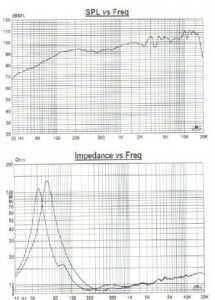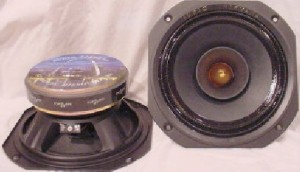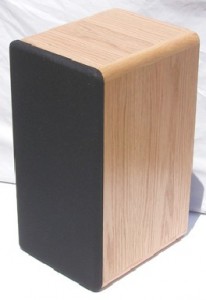Specifications:
- Cabinet style: Woodstyle WS803
- Driver type: Audio Nirvana Super 8”
- Power Requirements: 5-30
- Watts Frequency Response: 38-20k
- Sensitivity: 95db
- HWD:
- Price: DIY $340
Within the last decade the audio world has rediscovered the simple beauty of music reproduced through single driver speakers. While full range driver manufacturers were always available, only a handful of audio enthusiasts were aware of the benefits of this type of speaker. A few companies, such as Lowther and Fostex stayed the course, and continued to advance the development of full range drivers. The offerings of these companies found enthusiastic followers in Europe and the Far East; while the majority of the U.S. market preferred traditional multidriver speaker system. However, adventurous American audio enthusiasts chose to follow a road less traveled, and began to explore this alternative philosophy of music reproduction. Tube amplifiers were commonly used with this type of speaker, primarily due too the high sensitivity ratings of these drivers. Audio enthusiasts found that single driver speakers matched up quite well with vintage tube amplifiers, such as classic units from Fisher, Marantz, or Heathkit. Advocates of lower powered solid-state gear also discovered that a full range driver works well within their types of systems. Only recently has the full range driver registered on the radar screen of the mainstream audio community. This success has created an opportunity for audio enthusiasts to experience the unique benefits of single driver speaker systems.
David Dicks, of Common Sense audio created the Audio Nirvana drivers in response to Fostex discontinuing the FE 164 driver. David is an advocate of using full range drivers in a vented cabinet arrangement. The FE 164 was ideally suited for this kind of application, whereas the new FE 166 and FE 167 drivers did not excel in a bass reflex loading system. The new Fostex units had an excursion travel of + or – .6 millimeters, which were too short to generate acceptable levels of low frequency output in a vented cabinet. The Audio Nirvana drivers are designed to have 1.0 millimeters of travel, which allow these speakers to produce acceptable amounts of bass in a very simple bass reflex enclosure. This is a very important attribute for the audio enthusiast who is working on a limited budget. It is now possible to obtain the benefits of full range drivers without having to build complex and costly cabinets for them. While bass response is always a concern with full range drivers, David Dicks has created an interesting choice for his customers. The Audio Nirvana line contains speakers from 6.5 inches in diameter, and continues all the way up to a massive 12-inch full range speaker. As you move up the Audio Nirvana line, it becomes possible to obtain deeper bass performance without resorting to exotic cabinet designs.
Audio Nirvana Super 8 review
The Audio Nirvana Super 8 is the driver I currently have on hand for evaluation. This is an 8-inch diameter driver that employs a whizzer cone for high frequency reproduction. This driver is a step up from the standard 8-inch speaker due to the addition of a copper finished phase plug. The phase plug redirects and focuses the sound waves coming from the center portion of the speaker cone. Without the phase plug, the speaker exhibits early reflection problems within the cone. These reflections end up smearing the overall presentation of the speaker. The Audio Nirvana drivers use an accordion style surround that is formed out of a treated linen material. This type of surround is known for its consistency and long life span. It is unusual to see this type of surround used in speakers residing at this price point. A ferrite magnet structure is employed, and appears to be quite adequate for the job at hand. The magnet assembly is cradled in a stamped steel basket, although cast baskets have recently become available for several speakers in the Audio Nirvana lineup. It is interesting to note that the sensitivity of this speaker is 96db, which is quite high for a speaker this size. This makes the Audio Nirvana speakers a natural match for lower powered amplifiers. This high efficiency rating means that the Audio Nirvana drivers could match up with 5 watt per channel flea powered tube amps, or even a high quality 30 watt per channel integrated amplifier. There are other advantages to high sensitivity speakers besides high output volume. High efficiency speakers can recreate the dynamic contrast of a musical performance much easier than a speaker system that uses less efficient drivers. When you look at the overall build quality of the Super 8, it is evident that these are a well thought out design, with competent execution of the manufacturing process.
For my evaluation process the Audio Nirvana drivers were housed in a standard bass reflex configured speaker cabinet. The cabinets are Woodstyle WS 803 and can be found through companies providing speaker kits such as Madisound or Parts Express. These are tidy looking cabinets with an attractive cherry veneer finish. There is a 3-inch port located below the speaker on the face of the cabinet. The cabinet is lined with a sheet of Dacron in order to lessen the effects of unwanted reflections within the cabinet. A respectable pair of non-descript binding posts is used to accept input from the speaker cables. This cabinet configuration is a very cost effective way to utilize the Audio Nirvana speakers. The cabinets can be ordered for approximately $160 a pair, and binding posts should cost no more than $10 a piece. You could easily obtain the Dacron dampening material and internal wiring for less than $20. Finally, the Audio Nirvana Super 8 drivers will set you back $148 a pair. So the total cost of parts for this project will be in the range of $350. Of course this calculation does not take into account the time you spend in assembly, but this is a pretty simple audio project that can be easily completed in a weekend.
I placed each Audio Nirvana speaker on a Target HS 28 stand that has been filled with 30 pounds of sand. The speakers were placed 6 feet apart, with a moderate amount of toe in angle. David Dicks informed me that these speakers prefer to be located close to the rear wall. My listening sessions confirmed this point, and I positioned them within 6 inches of the rear wall of my listening room. This is a very practical attribute that is not found in many speakers today. Audio enthusiasts who have space limitations will have a very easy time setting these speakers up. I primarily used the Electra-Print 300 DRD amplifiers for my evaluation period, although the Monarchy SM 70 PRO’s were also pressed into service. The Electra-Print PVA handled the preamplifier duties. A Sony SCD-595, which has been modified by Tube Research Labs, is used in the source component position. Audio Magic cables were employed throughout the system. These drivers were already broken in, and I was ready to begin my listening sessions after a few days of casual listening.
Single driver speakers traditionally excel in two main areas. The excellent quality of vocal reproduction by the Audio Nirvana drivers highlights the superiority of full range drivers. The Audio Nirvana’s vocal reproduction on “Save Yourself For Me”, by Hiroshima [Another Place; Epic EK39938] was in the same league as high quality electrostatic speakers. There is a level of speed and clarity to June Kuramoto’s vocal performance that I have not heard from many other speakers. The Audio Nirvana drivers actually sounded very similar to a pair of Acoustat 1+1 that I have previously owned. The back up singer’s vocals also had a very nice texture to their voice. While the Audio Nirvana drivers did turn in an admirable performance, I should note that the speaker does have a slightly forward presentation in the midrange. My listening sessions reveal a slight peak in the upper midrange region. It is quite pleasant to listen to, but readers should be aware that these speakers do exert a bit of their own character over the music. Overall, I would say the Audio Nirvana drivers turned in a worldclass performance in the midrange area. I have experienced only a handful of speakers that are on equal footing in regards to vocal reproduction.
The ability to create realistic soundstage is the other area that full range speakers typically surpass their multi-driver counterparts in. The Audio Nirvana speaker does not have to deal with multiple radiation patterns that afflict typical multi-driver speaker systems. Since there is no crossover in this speaker system, any phase shift issues are also eliminated. What this means is that the Audio Nirvana Super 8 will present an accurate rendition of the acoustic environment found within a record piece of music. “Straight, No Chaser” by The lonious Monk [Straight, No Chaser; Columbia CK64886] proved to me that these speakers are capable of creating an image that in quite realistic. This is a SACD re-issue of a jazz classic that has been re-mastered by a group of very talented sound engineers. The Audio Nirvana speakers place instruments in a realistic acoustic space. These speakers also maintain a believable distance in between performers. For instance Monk’s piano has an appropriate size in the soundstage in relation to the drum kit and tenor sax. The soundstage that is created by the Super 8’s is one that projects itself into the room. Some speakers will develop a stage that resides behind the speaker, and this attribute is often referred to as a “deep” soundstage. In my listening sessions, the stage developed by these speakers ended at the rear wall of the listening area. However, the performers were projected ahead of the speakers, thereby creating a soundstage that was closer to my listening seat. You may prefer one type of soundstage presentation to the other, but personally I was quite satisfied with the aural illusion that the Audio Nirvana speakers created.
David Dicks has gone to great lengths to optimize the wizzer cone’s high frequency response in his drivers. Historically speaking, the vast majority of full range drivers do not have the extension in the treble region that a dedicated tweeter will exhibit. Many audio enthusiasts end up supplementing their full range drivers with super-tweeters in order to address this issue. In my conversations with David, he informed me that the Super 8 has usable high frequency output up to 18,000 hertz. This is a refreshing piece of news. It means that the audio enthusiast who uses the Super 8’s will not have to go through the added expense and effort of blending in a super-tweeter. “Angles of the Sun by Greg Greenway [Singing For the Landlord; Eastern Front EFR108] contain several metal stringed instruments that develop significant amounts of high frequency energy. The Super 8’s did an admirable job of recreating the edgy overtones of these instruments. The individual notes sounded crystal clear, and appeared to shimmer in the soundstage. The high frequency performance of the Super 8’s is extremely good, and I do not believe that a run of the mill soft dome tweeter would be capable of outperforming it.
All speakers have some type of limitation to their performance. A good designer recognizes the limitations within a specific speaker configuration, and strives to minimize the audible effects. Full range drivers usually have trouble developing significant amounts of deep bass response. Over the years speaker designers have developed intricate cabinet designs to address this issue. However, most audio enthusiasts with a limited budget do not have access to the equipment needed to build a complicated cabinet. A simple bass reflex cabinet is the most cost effective way to maximize the usable bass response of the audio Nirvana drivers. The Super 8’s performance in a bass reflex enclosure is an elegant compromise between bass extension and overall cabinet cost. David Dicks states that the Super 8 output is 4db down in the mid 50 hertz range. What the Audio Nirvana lacks in pure bass extension, it more than makes up difference in the overall tonal quality of the lower registers. “Little Boy Blue” by the Holly Cole Trio [Temptation; Capitol CDP 7243 8 31663 2 2] sheds plenty of light on the high and low points of the Super 8’s bass performance. The opening notes of this song begin with a bluesy bass line that always gets my feet tapping. The acoustic bass is the showcased instrument on this song, and is mixed into the forefront of the recording. The Super 8’s do a fine job of presenting the texture and subtle nuances of David Piltch’s performance. What I do miss with these speakers is the physical power of the bass notes. This song should have more of a physical presence in the bass region, which I cannot coax out of the Super 8’s as a standalone speaker. In light of the moderate cost of this speaker project, this is a reasonable compromise in this speaker design. The Super 8’s in a vented bookshelf size enclosure really is a candidate for being paired up with a powered subwoofer. Another option is stepping up the Audio Nirvana line and utilizing one of their larger full range speakers. I understand that the 12-inch version is capable of reaching down into the 30-hertz range.
When I spoke with David Dicks about the Audio Nirvana drivers, he made a strong case for the superiority of full range speakers in bass reflex configuration. While I might not agree entirely with David in this regard, I will say that his drivers do perform exactly how he claims they will. The Super 8’s have an exquisite midrange presentation, and they are capable of throwing a sizable soundstage. The overall speed and clarity of this driver sets a difficult target for other moderately priced drivers to attain. The cost of the parts needed to complete a bookshelf kit of the Super 8’s is fairly inexpensive. For the audio enthusiast who is operating within a real world budget, the Audio Nirvana drivers offer an opportunity to experience high quality musical reproduction.
Associated Equipment:
- Tube Research Labs modified Sony SCD-595
- Monarchy SM 70 Pro amplifiers
- GR Research Paradox One speakers
- Tara Labs Air 3 interconnects
- Tara Labs RSC Master Gen II speaker wire
- Audio Magic Extreme power cords
External link: Common Sense audio
from affordableaudio, By John Hoffman




Thanks for the nice review of the Audio Nirvana Super 8s. I heard a some Audio Nirvana’s in reflex cabinets by John Tucker at the rocky Mountain Audio Fest last weekend, Oct 2,3,4, 2015. He had done his mods on them which I ‘m sure helped a bit and they were from the “classic” line, no doubt the alnicos, 10 inch I think, , but they sounded so wonderful when playing very musical material. I can’t afford the Exemplars, but I will be able to get some variation of David dicks work.
Bill Davis
Santa Fe NM
Nice review. Thank you. I’m putting together a car stereo right now, and my next project I have planned is a home setup. I’m doing a similar idea on my car. Using a 12 inch sub in the trunk. A pair of 6.5inch Silver Flutes up front from 80hz to 250hz, and 3 or 4 inch full range for the rest. This idea makes a lot of sense. It may not sound as good if there’s a lot of stuff going on in the song, But if it’s a simpler recording, like a jazz quartet. Nothing will beat a single speaker. If you understand even basic sound reproduction, then common sense will tell you this is the best way to go.
If these speakers are anywhere near as good as people say they are. Then I can’t think of a better way to spend your audio budget. I am a relentless researcher. But as of right now these are on the top of my list. I know there’s most likely better, but not at this price level it seems.
I have their 8” neodyniums, that replaced very expensive Swiss Aers whose surrounds became dust, and one oice coil rubbed itself away. At a fraction of the price, these AN neos are MUCH richer and cleaner sounding.. in Doppenderg’s Oris Horns, with EL8 tube amps.